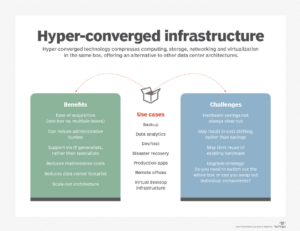How Hyperconvergence Benefits Virtual Desktop Infrastructure
Some of the links in this post are affiliate links. This means that if you click on the link and/or purchase an item, I will receive a small commission at no extra cost to you. Thank you for helping me earn a little coffee money and afford to create more great content.
Over the last decade, Hyperconverged Infrastructure (HCI) has gained popularity as an infrastructure solution for mission-critical workloads. Hyperconvergence platforms package compute, storage, virtualization, and networking into a single appliance to provide simplicity and agility. It is beneficial for businesses looking to modernize their infrastructure using virtual desktops due to the rising demands for remote work.
Around 25% of all North American professionals are expected to hold a remote position by 2023. Building a Virtual Desktop Infrastructure (VDI) using hyperconvergence can cost-effectively help businesses prepare and stay current for expanding remote work environments.
Why Hyperconvergence?
Hyperconvergence has emerged as a strategic IT solution to simplify deployment, increase flexibility, increase scalability, and lower costs. It consolidates computing, storage, and networking into a single tier.
Even though IT teams have more control when the tiers are separated into a 3-tier system, they also have to individually deploy and manage each tier. Additional time and resources are necessary to learn all the interfaces and manage the infrastructure. IT organizations often have separate teams dedicated to each tier with specialized knowledge (e.g., server team, network team, storage experts, etc.). Also, as organizations grow in size, the complexity increases. Organizations must allocate more resources to maintain the 3-tier systems, and team collaboration become difficult.
HCI uses hypervisors to manage virtualized computing and networking with software-defined storage. A hyperconverged platform is supported by a single vendor. As a result, IT teams can manage the integrated servers, storage, and networking instances through a single vendor interface, thus decreasing the complexity of deployment and management while still having control of the tiers.
But the control capabilities of hyperconverged platforms can significantly differ from vendor to vendor. IT teams should test out a particular solution before committing to a vendor long-term.
HCI Simplifies and Accelerates Virtual Desktop Infrastructure Deployment
Virtual Desktop Infrastructure (VDI) helps IT teams manage virtual desktops in central servers and deploy the instances to end-users on-demand. Users can access the virtual desktops remotely. VDI is a great way to meet the demands of digital transformation and remote workforce enablement. However, implementing VDI was complex and costly in the past. But the adoption of HCI has made VDI a more viable option for businesses.
Organizations can use HCI to build virtual desktop environments. The integrated servers, storage, and networking of HCI provide the abstraction layer perfect for quickly and efficiently deploying and managing virtual desktops. HCI is particularly a great fit for workloads like virtual desktops with a linear growth trajectory for computing, storage, and networking resources. IT teams can use HCI platforms to scale their infrastructure as users grow. Fewer resources are wasted figuring out individual tier resource requirements to meet increasing demands. Resource allocation and deployment can be managed from a single vendor interface. Also, IT teams can talk to a single vendor about any infrastructure issues.
For IT teams, a VDI built on HCI provides the following benefits:
● Faster deployment of virtual desktops
● Easy management of the VDI environment
● Lower costs due to saving on IT resource spend
● Single vendor to contact for support
The downside of HCI is vendor lock-in. Businesses have to request additional resources from the same vendor when they want to grow their infrastructure. However, the flexibility and scalability of VDI built on HCI might outweigh the drawbacks depending on business priorities.
One option to consider seriously for VDI is HPE Simplivity. Their 380 and 325 platforms are built on the Proliant DL380 and DL325 Gen10 servers. Coming in 1U and RU form factors, and scalable to 96 nodes, they have the form factor and scalability you need for VDI. Built-in features like depublication and compression, and access to HPE Infosight, add further value to the Simplicity platform.
VDI Built on HCI Helps Businesses Get Ready for the Future
HCI-based virtual desktop environments have become a trusted solution for the growing needs of remote work. Businesses looking to expand their VDI deployment capabilities can rely on the usability and scalability of hyperconvergence to conserve IT resources while meeting infrastructure demands.




